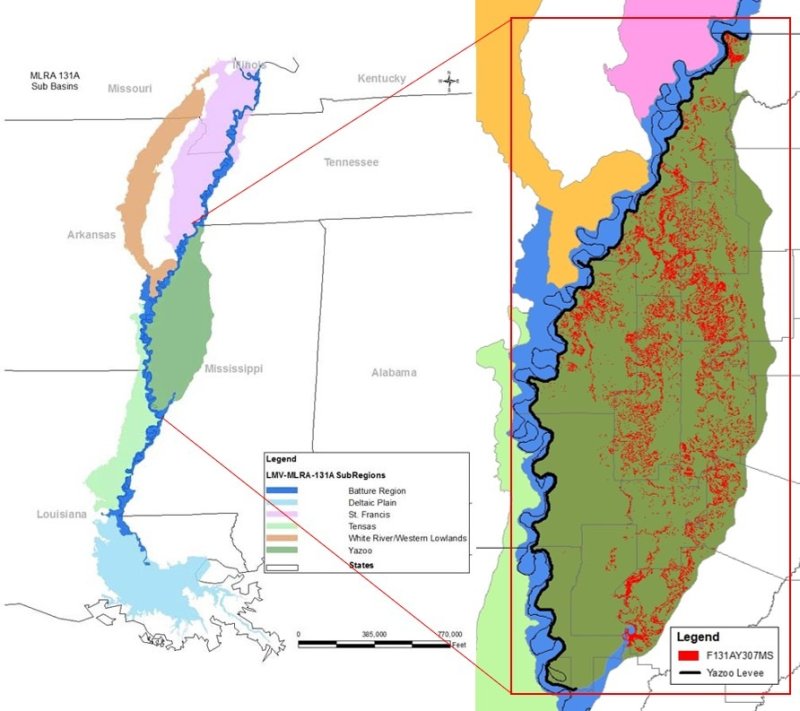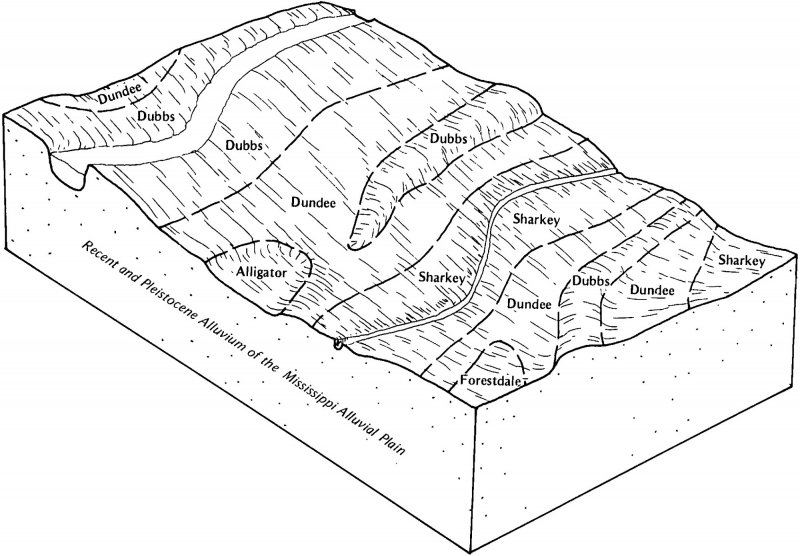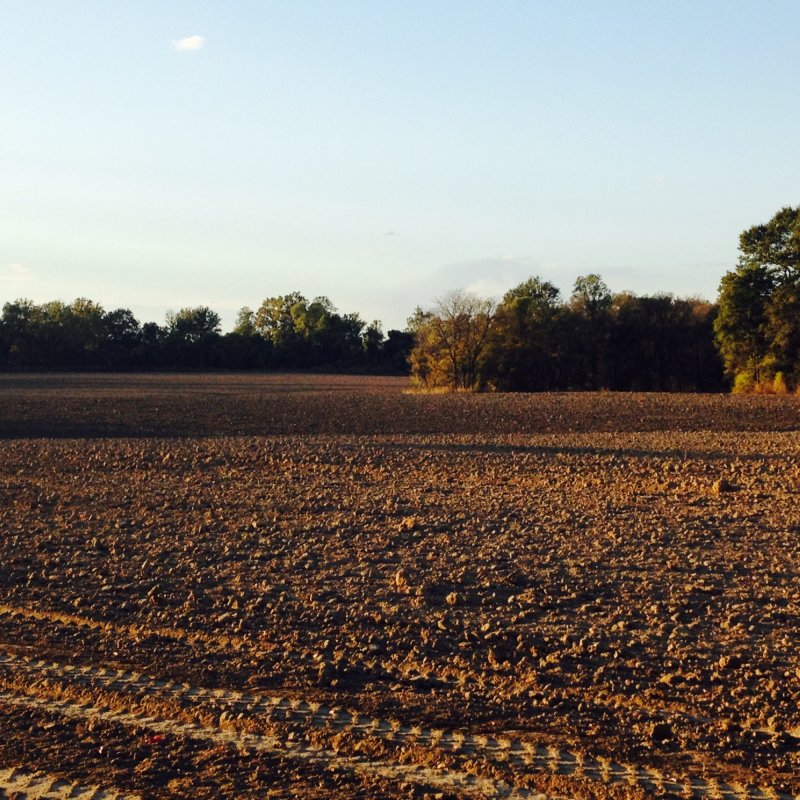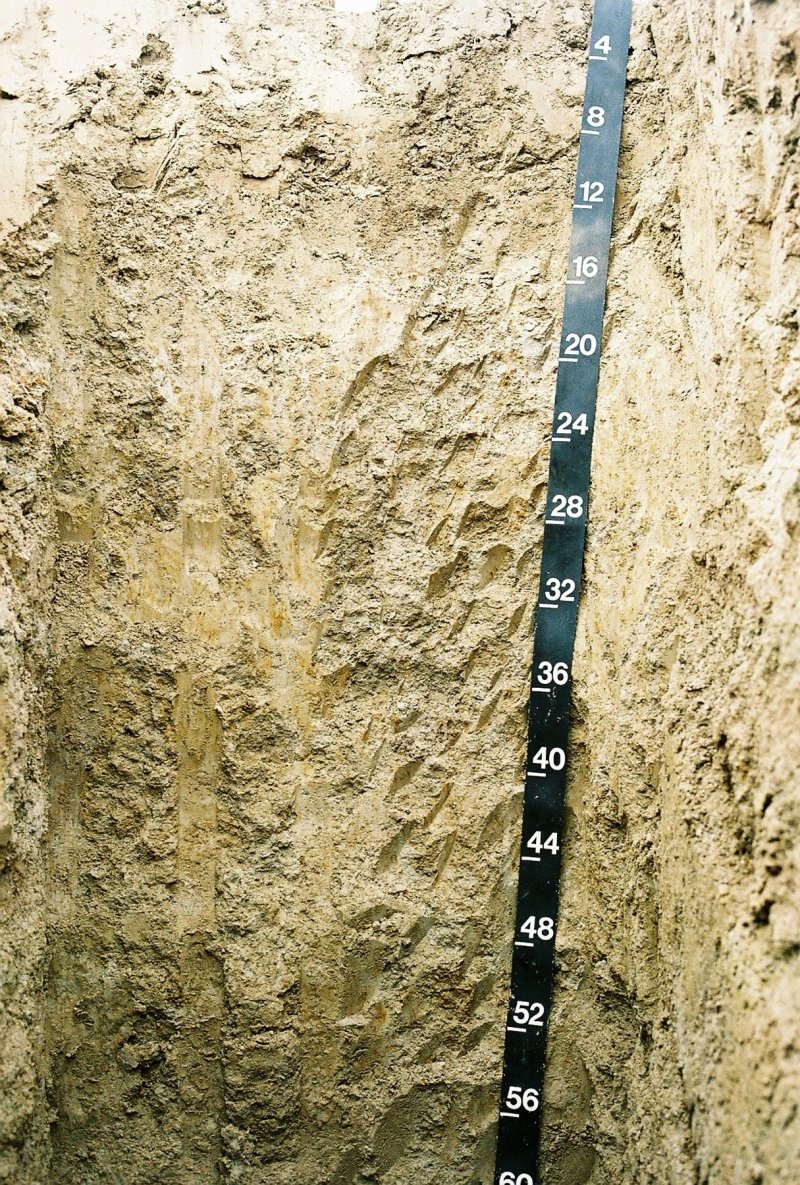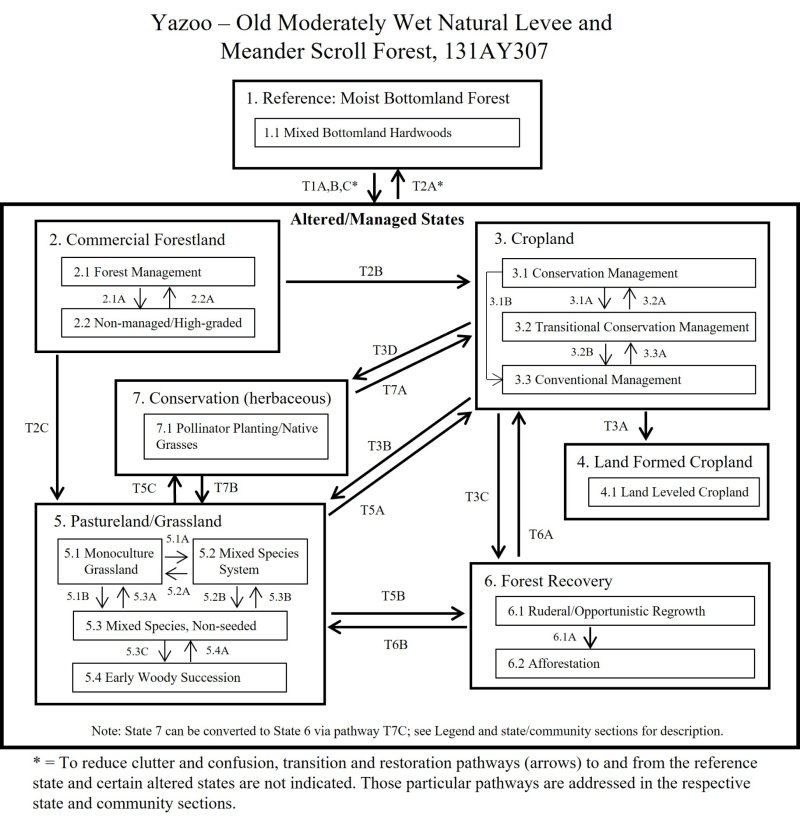Ecological dynamics
Historically, this ecological site was part of a vast forested landscape with processes and functions directly connected to the highly dynamic nature of the Mississippi River (Gardiner and Oliver, 2005). Today, this site is effectively disconnected from the Mississippi River via the vast network of constructed levees and, in many areas, local drainage controls. Widespread changes to the landscape occurred long before any intensive studies of the historic natural communities were conducted. Accordingly, reference conditions of this ecological site are still under review and consideration.
Putnam and Bull (1932) described their willow oak – cherrybark oak – cow oak (swamp chestnut oak) type as having characteristics of soil, moisture, and elevation midway or intermediate to the “typical flats and typical ridges.” They also mentioned the type occurring on undulating topography with a mixture of flat and ridge conditions. It can’t be assumed that the authors were describing or “typing” this ecological site without further investigation. However, their general descriptions of the landscape position and characteristics of that association are similar to the geomorphic features of this soil-site environment. Dominant components of their type include willow oak, cherrybark oak, swamp chestnut oak, Nuttall oak, and water oak with associates of sweetgum, American elm (Ulmus americana), green ash, persimmon, and sugarberry (Celtis laevigata). They emphasized that much variation occurred among and between stands with respect to sub-types, species dominance, co-dominance, and even presence/absence of some components.
Putnam and Bull’s type was never widely accepted and was likely absorbed or included into more broadly accepted forest types such as the swamp chestnut oak – cherrybark oak type (Society of American Foresters, SAF, type No. 91), sweetgum – willow oak type (SAF type No. 92; Eyre, 1980) or the sweetgum – red oaks species association (Hodges,1997; Meadows and Stanturf, 1997). One important characteristic that has been repeatedly stressed by forest authorities is the transition of all the aforementioned forest types to a sugarberry – American elm – green ash forest association (SAF type No. 93; Eyre, 1980) following major disturbances such as heavy cutting and/or repeated partial harvests (Putnam and Bull, 1932; Putnam, 1951; Hodges, 1997; Oliver et al., 2005). Today, the prevailing association occurring on this ecological site may be the sugarberry – American elm – green ash forest association or a variant of this type given the intensive land use histories most areas have incurred. Eyre (1980) provides a general description of the sugarberry – American elm – green ash type and several components listed above are associates of that type including species that are highly favored in management on this ecological site, such as Nuttall oak, willow oak, water oak, sweetgum, and green ash. (An expanded list of trees favored in management is included in the narrative of State 1 of the State and Transition Model, below.) Given the landscape position of this ecological site as being intermediate to higher (drier) and lower (wetter) ecological sites, it is very likely that a gradation or overlapping of vegetation types naturally converges on this soil-site environment. Historically, this site was likely rich in species diversity and complexity.
Overall, forest cover on this site is minor compared to other uses. Most areas have been cleared and are used for growing cotton, corn, soybeans, and small grain. This site is used extensively for row crop production and some areas have been land leveled up to 3 feet to meet irrigation needs. A secondary use on this site is pasturage.
Following this narrative, a “provisional” state and transition model is provided that includes the “perceived” reference state and several alternative (or altered) vegetation states that have been observed and/or projected for this ecological site. This model is based on limited inventories, literature, expert knowledge, and interpretations. Plant communities may differ from one location to the next depending on the severity of local land use activities and rates of deposition. Depending on objectives, the reference plant community may not necessarily be the management goal.
The environmental and biological characteristics of this site are complex and dynamic. As such, the following diagram suggests pathways that the vegetation on this site might take, given that the modal concepts of climate and soils are met within an area of interest. Specific locations with unique soils and disturbance histories may have alternate pathways that are not represented in the model. This information is intended to show the possibilities within a given set of circumstances and represents the initial steps toward developing a defensible description and model. The model and associated information are subject to change as knowledge increases and new information is garnered. This is an iterative process. Most importantly, local and/or state professional guidance should always be sought before pursuing a treatment scenario.
State 1
Reference: Moist Bottomland Forest
Removal of the pre-settlement natural communities of this site occurred long before thorough studies and investigations were conducted. Accordingly, reference conditions for this site have yet to be confirmed. Once assigned, that vegetation community will not represent the pre-settlement forest association, but it should identify an assemblage of naturally occurring species that reflects and contributes to the regional biodiversity and local forest ecology. The reference state will be based on decades of forest inventories and expert knowledge and opinion.
The return or transition pathway from the altered states back to the reference state is intended to represent the suite of hardwood species favored in management on this site.
Community 1.1
Mixed Bottomland Hardwoods
A specific community or forest type that is representative of reference conditions has not been determined. The position of this site being intermediate to the drier, loamy natural levee ridges (see site F131AY306MS) and the wetter, natural levee toeslopes (see site F131AY308MS) creates a setting that likely include forest components adapted to both extremes. Putnam and Bull’s (1932) willow oak – cherrybark oak – cow oak type includes species that are associates of both sites. Broadfoot (1976) listed several species (mutually in Putnam and Bull’s description) that are both favored in management and that frequently occur on the soils of this site, including Nuttall oak, cherrybark oak, water oak, willow oak, and sweetgum. Broadfoot also listed the following associates to favor in management that occasionally occur on these soils: green ash, eastern cottonwood, American sycamore, swamp chestnut oak, and pecan (corroborated by Steve Meadows, USFS Principal Silviculturist, personal communication to Rachel Stout Evans, contributing author). As an example of the productivity of this site, the following are site index ranges (tree height in feet at 50 years except cottonwood which is 30 years) of the preceding species from Broadfoot (1976): Nuttall oak – 85 to 105; cherrybark oak – 90 to 110; water oak – 85 to 105; willow oak – 90 to 110; sweetgum – 90 to 110; green ash – 70 to 90; eastern cottonwood – 90 to 110; American sycamore 95 to 115; swamp chestnut oak – 70 to 90; pecan – 80 to 100.
Typical of forests in moist environments of the Mississippi River Alluvium many additional species are associates of this site. Additional canopy and subcanopy taxa include American elm, sugarberry, red maple, red mulberry, common persimmon, cedar elm (Ulmus crassifolia), and boxelder (Acer negundo). Understory components of older stands without prior management likely include shade tolerant canopy and subcanopy trees such as elm, ash, sugarberry, red maple, and red mulberry along with shrubs of possumhaw (Ilex decidua), roughleaf dogwood (Cornus drummondii), and hawthorn (Crataegus spp.). Undergrowth consists of several vines including greenbrier (Smilax spp.), eastern poison ivy (Toxicodendron radians), peppervine (Nekemias arborea), American buckwheat vine or redvine (Brunnichia ovata), trumpet creeper (Campsis radicans), Carolina coralbead (Cocculus carolinus), Virginia creeper (Parthenocissus quinquefolia), and grape (Vitis spp.). Herbaceous taxa may include bedstraw (Galium spp.), violet (Viola spp.), bluestar (Amsonia spp.), and jewelweed (Impatiens capensis) (Eyre, 1980; NatureServe, 2020).
The arrangement of tree species listed in the Dominant Plant Species table below follows the same order of importance (i.e., decreasing dominance) as indicated in the sweetgum – water oaks forest type in Putnam (1951). Putnam's list is interpreted to be more representative of natural variability than ranking the species by commercial value.
Dominant plant species
-
sweetgum (Liquidambar styraciflua), tree
-
water oak (Quercus nigra), tree
-
Nuttall oak (Quercus texana), tree
-
willow oak (Quercus phellos), tree
-
American elm (Ulmus americana), tree
-
sugarberry (Celtis laevigata), tree
-
green ash (Fraxinus pennsylvanica), tree
-
pecan (Carya illinoinensis), tree
-
cedar elm (Ulmus crassifolia), tree
-
eastern cottonwood (Populus deltoides), tree
-
possumhaw (Ilex decidua), shrub
-
roughleaf dogwood (Cornus drummondii), shrub
-
hawthorn (Crataegus), shrub
-
greenbrier (Smilax), shrub
-
eastern poison ivy (Toxicodendron radicans), shrub
-
peppervine (Nekemias arborea), shrub
-
American buckwheat vine (Brunnichia ovata), shrub
-
trumpet creeper (Campsis radicans), shrub
-
Carolina coralbead (Cocculus carolinus), shrub
-
Virginia creeper (Parthenocissus quinquefolia), shrub
-
grape (Vitis), shrub
State 2
Commercial Forestland
This state consists of two very different community phases and management approaches. Community Phase 2.1 represents forest management and production on this site. A distinguishing feature of this phase is the level of management intensity designed to maximize merchantable goals. Various silvicultural methods are available for selection, and these are generally grouped into even-aged (e.g., clearcutting, seed-tree, and shelterwood) and uneven-aged (e.g., single tree, diameter-limit, basal area, and group selection) approaches (Meadows and Stanturf, 1997). Depending on the method selected, different structural and compositional characteristics of the stand may result. Removal and control of community associates are typically a critical element of production goals. These actions may result in different community or “management phases” (and possibly alternate states) depending on the methods used and desired results. Finding the appropriate approach for a given stand and environment necessitates close consultation with trained, experienced, and knowledgeable forestry professionals. If there is a desire to proceed with this state, it is strongly urged and advised that professional guidance be obtained and a well-designed silvicultural plan developed in advance of any work conducted.
Community Phase 2.2 represents conditions of many stands that have incurred indiscriminate timber harvests (e.g., heavy cutting, diameter-limit harvests of select species) and opportunistic regrowth following such harvests (i.e., no management at any period). Some stands may continue to support a few desirable species and quality stems, but in many instances, affected stands will be comprised of mostly shade tolerant species or trees of desirable species that fail to meet their maximum potential.
Although this site is well suited for forest production, seasonal wetness imposes moderate to severe limitations for some forest operations. Heavy equipment usage on wet soils can cause compaction, which may reduce site productivity. If possible, equipment operations are best conducted during drier periods of the year, which minimizes soil damage, erosion, and helps to maintain productivity.
An important caveat of this state is its representation of forest conditions that have retained full site production potential. Currently, transitional pathways to this state originate from another forested state (State 1), only. Former landuses (alternate states) that result in soil compaction (increased bulk densities), lower soil organic matter content, altered fertility, and smaller available rooting volume can reduce forest site production by 10 to 20 percent for some species (Groninger et al., 1999). These are conservative percentage reductions. The model from the Baker and Broadfoot (1979) method of site evaluation have produced site index values of over 20 percent lower than trees measured on non-impacted, forest soils. These impacts, however, can be ameliorated through various “afforestation” techniques such as plow pan breakup (subsoil or deep plowing), fertilization, and fallowing fields before stand establishment (Emile Gardiner, USFS Research Forester, personal communication with Rachel Stout Evans, contributing author). State 6 (Forest Recovery) is representative of forest establishment and growth on locations where soil compaction and reduction of nutrients have occurred. Once a previously affected location has recovered its site potential, transition to this state may be possible. That potential transition is still under review and is currently not shown or addressed in the state and transition model.
Community 2.1
Forest Management
Prescribing a silvicultural system for a given stand depends on species composition; long term production and postproduction goals; and the presence and abundance of advance regeneration (i.e., the presence of seedlings and saplings of the desired species). The canopy trees listed in State 1 as “favored in management” are all production options on this site ranging from single species plantations to complex multi-species stands. (Species favored in management are listed below for convenience.)
Establishing and maintaining oaks on bottomland sites may be preferred given the multiple values they provide (e.g., timber and wildlife). However, maintaining that component beyond a single rotation (or harvest) may be the most challenging. Creating conditions that promote oak persistence in future stands require a sufficient advance regeneration component. Ensuring that this future crop is established will require close adherence to a well-designed silvicultural plan, which requires programmatic intermediate operations (e.g., improvement cuttings, thinnings, and other partial cuttings). An even-aged silvicultural system that utilizes the clearcutting regeneration method along with brush management to reduce subsequent competition is typically the advocated approach when harvesting bottomland oak stands (Johnson and Shropshire, 1983; Clatterbuck and Meadows, 1993; Hodges, 1995; Meadows and Stanturf, 1997).
Except pecan, the remaining trees that are favored in management are light-seeded species. A variety of silvicultural systems may be implemented to promote production of these species including even-aged and group selection (uneven-aged) approaches (see Meadows and Stanturf, 1997).
Dominant plant species
-
Nuttall oak (Quercus texana), tree
-
cherrybark oak (Quercus pagoda), tree
-
water oak (Quercus nigra), tree
-
willow oak (Quercus phellos), tree
-
sweetgum (Liquidambar styraciflua), tree
-
green ash (Fraxinus pennsylvanica), tree
-
eastern cottonwood (Populus deltoides), tree
-
American sycamore (Platanus occidentalis), tree
-
swamp chestnut oak (Quercus michauxii), tree
-
pecan (Carya illinoinensis), tree
Community 2.2
Non-managed/High-graded
This forest community is directly influenced by former harvesting practices that include repeated single-tree selection or diameter-limit harvests with no additional management activities (e.g., brush management, competitor control, etc.). These practices typically target the highest quality trees of the most desirable species. The result is usually an expansion and in-filling of shade tolerant subcanopy trees. Over time, this practice will lead to a predominantly shade tolerant community that may be comprised of a variant of the sugarberry – American elm – green ash forest association, possibly with a plurality of sugarberry and elm. Additional shade tolerant components likely to occur consist of red maple, boxelder, red mulberry, roughleaf dogwood, and possumhaw.
Pathway 2.1A
Community 2.1 to 2.2
Heavy cutting of the stand that removes the desired species (typically shade intolerant species) of sufficient diameters followed by no management of the residual stand. This pathway also includes repeated single-tree harvests (e.g., diameter-limit cuts) that removes the desired species followed by no management of the residual stand. The resulting stand is typically comprised of shade tolerant species with low commercial value.
Pathway 2.2A
Community 2.2 to 2.1
Intensive management will be required to push a shade tolerant community into a more commercially desirable system. Actions will likely require a complete clearcut of the stand followed by repeated brush and competitor control (chemical and mechanical). If there is a lack of seed source, artificial regeneration will likely be required to reintroduce heavy-seeded species (oaks and pecan). Continual competitor control will be needed.
State 3
Cropland
This state is representative of the dominant landuse activity on this ecological site, agriculture production. The dominant crops grown on this site are cotton (Gossypium hirsutum), corn (Zea mays), soybeans (Glycine max), and potentially small grains such as wheat (Triticum aestivum). Minor crops, such as some specialty crops (e.g., fruits, vegetables, and tree nuts such as pecans), may be grown locally.
The soils of this site are well suited to agriculture production. Management concerns are centered on seasonal wetness, soil compaction from heavy equipment operations, and the development of a plow pan. Pringle et al. (2017) emphasized that a “fairly impermeable crust” tends to develop following a heavy rain or an irrigation event. Each of these factors could affect yields or impede optimum operation. Management measures to ameliorate some of these issues may include implementation of a drainage system or network in problematic areas; implementing a conservation tillage or management system; subsoiling to breakup plow pans (USDA-NRCS, 2006b). Major components that producers generally develop and plan are proper selection of crop cultivar, pest control, cropping system, tillage methods, nutrient management, and water management. Key practices of some cropping systems often include two or more crops grown in a multiyear rotation, which has been documented to disrupt pest cycles. Leaving crop residue on the surface can help to maintain tilth, fertility, and organic matter content – all critical elements of soil quality and health. For monoculture cropping systems, the implementation of well-designed pest and nutrient management systems are imperative (Pringle et al., 2017). (For assistance, interested parties are advised to visit their local NRCS Field Office.)
Three separate management phases comprise this state: Conservation Management (3.1), Transitional Conservation Management (3.2), and Conventional Management (3.3). The three phases consist of varying tillage methods and approaches to soil health management systems.
Community 3.1
Conservation Management
This cropland phase utilizes long term, continuous conservation management systems that include reduced till and cover crops; no-till with cover crops; crop residue retention; and perennial cropping systems. The guiding principles of this system are minimizing soil disturbance and maximizing soil cover, biodiversity, and the presence of living roots. Implementing diverse crop rotations while maintaining these principles can lend to the development of an integrated pest management plan and contribute to overall system resilience.
Of caution, the above-ground crop growth or yields may not be the best tracking mechanism for assessing the efficacy or presence of this management phase. Indicators of these systems are generally determined via soil-site assessments with outcomes that may include enhanced soil aggregate stability, increased soil biological activity, higher organic matter content, and improved water holding capacity and infiltration rates while also alleviating soil compaction and reducing runoff and erosion (Chessman et al., 2019). Additional advantages to this system that have been noted by some producers are reductions in fuel and labor costs and less wear and tear on machinery and equipment.
There are challenges to this management system, especially in situations where tillage may be considered and/or needed to repair weather damage or other detrimental impacts. Implementation of conventional tillage even after long term conservation practices (e.g., no-till) can reset the affected area back to a conventional cropping system. However, those changes can be reversed and a return to a conservation management system is achievable.
Critical conservation practices associated with this phase include cover crops, no-till, and reduced till as the foundational practices. Additionally, this phase may include supporting and/or site-specific practices to address conservation needs for a given location.
Community 3.2
Transitional Conservation Management
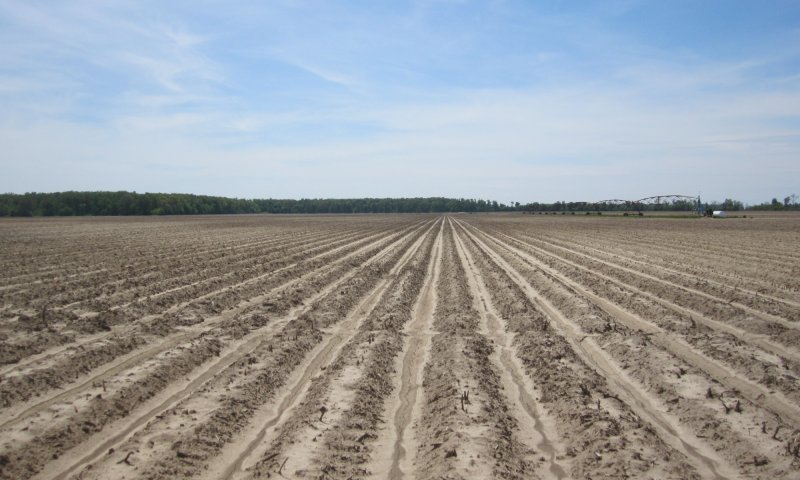
Figure 13. Undulating natural levee over older meander scroll Dundee sil, 0-3% slopes, Coahoma Co., MS.
This cropland phase utilizes a hybrid approach that combines conventional methods with conservation practices at specific periods and under specific situations. Practices under this phase may include a combination of conventional till, reduced till, strip till, and the inclusion of cover crops. For instance, perennial crop species could be in a continuous transitional phase where conventional tillage is implemented at the time of planting followed by reduced tillage during the rotation. Planted forage crops could also be included in this phase, especially when part of a crop rotation that utilizes reduced tillage for one crop followed by conventional tillage for a succeeding crop.
The development, implementation, and refinement of nutrient and pest management plans throughout component operations are imperative. Additionally, this phase may include supporting and site-specific practices to address conservation needs for a given location.
Community 3.3
Conventional Management
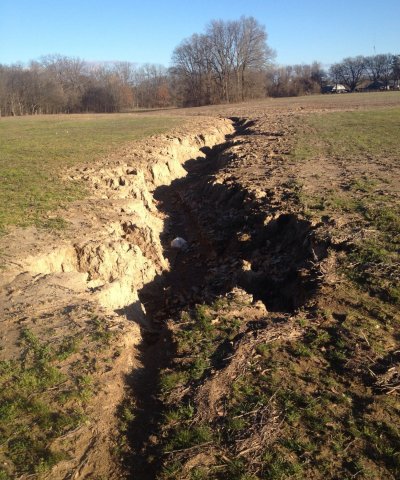
Figure 14. Erosion on ridge and swale meander scroll, Sunflower Co., MS.
This management phase is representative of conventional cropland where tillage is implemented as an annual component of the production system. As crucial elements of the system, conservation practices such as nutrient and pest management are needed to address fertility requirements and pest concerns within the crop cycle. It is important to note that this phase may develop when tillage is implemented to address damage or for other purposes while under a conservation management system (Community Phase 3.1). There could also be associated, supporting, and site-specific practices that are needed to address specific conservation needs. Specific needs may include grade stabilization structures to control gully erosion, grassed waterways to trap sediment from sheet and rill erosion, or implementing reduced till.
Pathway 3.1A
Community 3.1 to 3.2
Soil disturbance (tillage); reduction of soil health.
Pathway 3.1B
Community 3.1 to 3.3
Conventional tillage, seeding, and fertility management for crops.
Pathway 3.2A
Community 3.2 to 3.1
No-till, cover crops, reduced till–soil health improvements.
Pathway 3.2B
Community 3.2 to 3.3
Transitional Conservation Management
Conventional tillage, seeding, and fertility management for crops.
Pathway 3.3A
Community 3.3 to 3.2
Transitional Conservation Management
Reduced till, no-till, and cover crops with soil health improvements as a goal.
State 4
Land Formed Cropland
This gently sloping to undulating ecological site typically adjoins nearly level to level landscapes. It is bordered by soils of varying textures and drainage characteristics. Accordingly, inconsistencies in wetness, ease of operation, and production or yields may occur across a cropped location. An increasingly common practice on this site consists of land forming or leveling surface irregularities into a predetermined and engineered, uniform slope. This practice removes the drier and higher features of this site, which are then used to fill wetter and lower positions (e.g., depressions or swales) across the targeted area. Advantages of land leveling may include reduced hazards of erosion and runoff rates, improved surface drainage, and enhanced distribution and conservation of irrigation water. Disadvantages of the practice is a churning of various surface and subsurface materials (former soil horizons) that no longer occur in a predictable or regular pattern. Organic matter content in the surface layer is generally low, and the surface tends to crust and pack after heavy rains (USDA-NRCS, 2006b). One potential hazard that appears to be emerging in some areas is an effective management of surface water runoff. As both irrigated and stormwater runs off leveled fields at uniform rates, surface water tends to collect cumulatively and simultaneously, which places tremendous demands on local drainage networks. Without “in field” structures (natural or artificial) to stagger runoff, the downslope (or lower) ends of some fields tend to back flood thereby contributing to more flooding overall in local watersheds (personal observations).
Immediately following land leveling, the constituent elements of soil health are likely to be absent. In some areas, producers have initiated practices such as applying organic residues (e.g., poultry litter) or growing rice crops for one to two years to rapidly boost fertility and introduce organic matter (via rice biomass) in the surface layer. Over time, the full complement of the management phases of State 3 may be possible on land leveled fields. They are not repeated here.
Currently, this state serves as an endpoint in the state and transition model because the ability to predict vegetation response when transitioning to a different state is no longer possible without soil-site investigations for each area of interest. The former soils of this ecological site, including surface and subsurface horizons, will have been redistributed as particles among other former soils.
Community 4.1
Land Leveled Cropland
Some of the crop species and management practices indicated and discussed in State 3 (including all three management phases) may be suitable for establishing on land leveled areas that once supported the soils of this site. However, the type of crops suited for newly leveled areas may ultimately depend on the prevailing soil particle-size distribution and internal drainage characteristics. Former studies on precision leveled fields have noted variabilities and inconsistencies in soil particle-size distributions, bulk density, soil biological properties, and nutrients (Brye et al., 2003; Walker et al., 2003; Brye et al., 2006). Management concerns for this phase may consist of restricted permeability, low organic matter content, and crusting and packing (USDA-NRCS, 2006b). These impacts may be improved by implementing conservation tillage, cover crops, retaining crop residue, and nutrient and pest management strategies.
State 5
Pastureland/Grassland
This state is representative of sites that have been converted to and maintained in pasture or grassland. In 1991, the soils of this site were placed in Pasture Suitability Group 11b for the State of Mississippi. The Dundee soils are generally considered well suited to most commonly grown forage species. However, there are some wetness limitations due to a seasonally high water table. Management concerns are mainly centered on soil compaction due to grazing, which may be improved or avoided by restricting grazing during wetter periods (USDA-NRCS, 2006b). Of caution, some annual winter plants naturally growing in wet locations (e.g., sedges and rushes) may be hazardous if consumed. Production is considered moderately high when adequately fertilized and properly managed.
Given that this ecological site adjoins lower, wetter sites, some forage operations may experience multiple wetness events in a single year, especially in pastures where wetter soils occur in complex or in close contact with those of this site. Flood-prone areas may limit the type of forage suited for this site. A system of artificial drainage or water control structures may be in place to facilitate continued forage production and grazing during wetter periods. Additionally, adjacent higher elevation or protected areas may be needed for the storage of harvested forage or holding of livestock when wet or flooded conditions occur.
Establishing an effective pasture management program can help minimize degradation of the site and assist in maintaining growth of desired forage. An effective pasture management program includes selecting well-adapted grass and/or legume species that will grow and establish rapidly; maintaining proper soil pH and fertility levels; using controlled grazing practices; mowing at proper timing and stage of maturity; allowing new seedings to become well established before use; and renovating pastures when needed (Rhodes et al., 2005; Green et al., 2006).
This state consists of four community phases that represent a range of forage management options and pasture/hayland condition scenarios. Options range from establishing a forage monoculture for haying to a broad mixture of forage species for production and grazing. It is strongly advised that consultation with local NRCS Service Centers be sought when assistance is needed in developing management recommendations or prescribed grazing practices.
Community 5.1
Monoculture Grassland
This phase is mainly characterized by planting forage species for hay production. Forage plantings generally consist of a single grass species. Native and non-native forage species can be seeded. Forage is usually harvested as hay or haylage, although grazing may occur periodically. These sites are highly productive for forage and can provide ecological benefits to control soil erosion. Allowing for adequate rest and regrowth of desired species is required to maintain productivity. Maintenance of monoculture stands also requires control of unwanted species, which will require pest and nutrient management.
Generally, the application of fertilizer and lime is needed to establish and maintain improved desirable pastures. Exceptions do occur for bahiagrass (Paspalum notatum) and common bermudagrass (Cynodon dactylon), which can be sustained under natural fertility and pH levels. Introduced grasses, such as hybrid bermudagrass, require a higher level of sustained fertility, pH above 6.0, and good surface drainage to persist. An additional measure to aid production may include prescribed grazing. Implementing limited and monitored grazing can promote deeper root penetration of grasses with the added benefit of greater nutrient and moisture uptake. This synergistic approach can lead to increased production of and may sustain desirable forages.
Conservation practices should include prescribed grazing, or forage harvest management, nutrient and pest management, and potentially other site-specific practices.
Community 5.2
Mixed Species System
This community is characterized by mixed species composition of grasses and legumes. Components of this forage system are either planted or they established naturally. Typically, perennial warm-season grasses are the foundation of the stand that are periodically overseeded with adapted cool-season forages. The latter creates an added benefit of extending the grazing season. This community phase can be highly productive for grazing and haying operations and can provide beneficial habitat for some wildlife species.
Maintenance of grass stands also requires a series of management practices such as prescribed grazing, brush management, pest management, and nutrient management to maintain production of the desired species. Prescribed grazing includes maintaining proper grazing or forage heights, timing, and stocking rates. Supporting or facilitating practices such as fences, water lines, and watering facilities could be part of the system that maintains this phase.
Community 5.3
Mixed Species, Non-seeded
This community is characterized by a mixture of native and naturalized non-native species. Forage is usually grazed and/or harvested as stored forage, hay or haylage. Common established species may include Bermudagrass, bahiagrass, Vasey grass (Paspalum urvillei), and carpetgrass (Axonopus sp.).
Stands are generally productive, and forage and grazing management can maintain the community. Healthy stands provide additional benefits by protecting soils from excessive runoff and erosion. However, a common peril associated with this phase is overgrazing, which lowers production and favors less palatable weedy species, especially in areas where livestock congregate. Proper stocking rates or grazing systems that allow for adequate rest and plant regrowth are required to maintain productivity. When forage species are afforded adequate recovery time between grazing intervals, they develop deeper root systems and greater leaf area. Conversely, when plants are not allowed to adequately recover, root development will be restricted leading to lower forage and biomass production. Additionally, maintenance of grass stands requires implementing pest management practices to control unwanted weedy and woody species.
Community 5.4
Early Woody Succession
This community is characterized by a diverse composition of grasses and forbs with an increasing presence of woody species (both native and non-native) that are immature and of low stature. Woody species grow quickly on this site and can be difficult and expensive to control. One potentially problematic species may be honeylocust (Gleditsia triacanthos). Putnam (1951) reported honeylocust as being common on old pastures, and the species can be difficult to remove once established. Management to transition this phase to other forage communities of this state is still possible without excessive inputs and effort, particularly if stem diameters remain below 2 inches and are widely scattered (e.g., a density of less than 100 stems per acre). However, if diameters become greater than 3 inches and densities exceed 300 stems per acre, far more investment, effort, and inputs will be required. If brush management measures are not undertaken, the plant community will transition to the Ruderal/Opportunistic Regrowth (Community Phase 6.1) of State 6.
Of note, this community phase is often very beneficial habitat for some wildlife species, especially a specific guild of resident and Neotropical migratory bird species that depend on old field to young tree stand habitats.
Pathway 5.1A
Community 5.1 to 5.2
Seeding and/or management for desired species composition.
Pathway 5.1B
Community 5.1 to 5.3
Species management without overseeding.
Pathway 5.2A
Community 5.2 to 5.1
Seeding, fertilizing, management/removal of undesirable species.
Pathway 5.2B
Community 5.2 to 5.3
Species management without overseeding
Pathway 5.3A
Community 5.3 to 5.1
Seeding, fertilizing, management/removal of undesirable species.
Pathway 5.3B
Community 5.3 to 5.2
Seeding and/or management for desired species composition.
Pathway 5.3C
Community 5.3 to 5.4
Lack of disturbance; no (infrequent) mowing, herbivory, or brush management; natural succession of woody species.
Pathway 5.4A
Community 5.4 to 5.3
Brush management/removal of unwanted species.
State 6
Forest Recovery
This state is representative of forest recovery in areas that were once under former intensive landuse such as long-term row crop cultivation. Characteristics that distinguish this state from other forest states on this site include a suite of soil-site properties that reportedly affect tree growth such as higher soil bulk density due to compaction, presence of a plow pan, lower organic matter content, and reduced fertility (Baker and Broadfoot, 1979; Groninger et al., 1999). Two community phases are provisionally recognized for this state. Community Phase 6.1 represents natural colonization of tree and shrub species without management. Community Phase 6.2 is representative of intentional forest establishment by artificial regeneration or planting.
For Community Phase 6.2, determining the objectives and goals of the future stand is imperative to increase the probability of successful establishment and production of the afforested area. These decisions will ultimately determine the species to be established, preparation requirements, planting density, and post-planting operations (e.g., competitor control, future improvement cuttings and thinnings, regeneration methods, and overall stand health). Since each area targeted for afforestation may have unique or different landuse histories, having a clear understanding of the soil-site conditions are essential. Some areas may necessitate a series of soil improvement actions prior to planting. These actions may include subsoiling or deep plowing to breakup plow pans and fertilizing the targeted area. An additional option is to allow the area to undergo fallowing for a predetermined period (Community Phase 6.1) to potentially increase soil organic matter content, enhance soil aggregate stability, increase soil biological activity, and improve water holding capacity and infiltration rates. Controlling competing vegetation (chemical and mechanical treatment) will most likely be critical. Post-planting operations and maintenance of the stand can enhance survival, future development, and achieve goals and objectives (see Gardiner et al., 2002).
Finding the appropriate approach for a given environment necessitates close consultation with trained, experienced, and knowledgeable forestry professionals. If there is a desire to proceed with this state, it is strongly urged and advised that professional guidance be obtained and a well-designed afforestation and silvicultural plan developed in advance of any work conducted. For an exceptional review and summarization of the afforestation literature, techniques, and practices within the Southern Mississippi River Alluvium, interested parties are directed to Gardiner et al. (2002).
Community 6.1
Ruderal/Opportunistic Regrowth
This community phase is representative of former working lands (e.g., cropland and possibly high concentration areas of former pastureland) that have fallowed and subsequently undergone natural colonization by trees and shrubs. A profusion of growth will initiate within five to eight years of becoming idle – one that typically includes woody seedlings, grasses, forbs, and an increasing presence and covering of vines. Some areas may be far removed from established forest stands. Under this scenario, colonizing tree species may be mostly light-seeded species (e.g., ash, elm, maple). Heavy-seeded species like oaks and pecan may not have an opportunity to colonize available areas due to distance and lack of a dependable dispersing agent (e.g., wildlife and water). For those areas close to a viable seed source, oaks may be a component of the developing stand, although in the early stages of stand development oaks are likely to be a minor component (Meadows, 1993). Non-native invasive species will, most likely, be part of the developing stand and could form the plurality of an area given the proliferation of exotic plant species over the past century.
As the young stand matures and enters the stem exclusion stage (crown or canopy closure), composition of light-seeded tree species may include American elm, green ash, cedar elm, boxelder, American sycamore, red maple, sugarberry, and sweetgum. Oaks that may occur in the young stand include willow, water, and Nuttall but will likely be rare or uncommon components, if present at all. Non-native woody species that may occur include Japanese honeysuckle (Lonicera japonica), Chinese privet (Ligustrum sinense), Chinese tallow (Triadica sebifera), and Callery pear (Pyrus calleryana). Vines common in the young, developing stand may include greenbrier, eastern poison ivy, peppervine, American buckwheat vine, and trumpet creeper. As the stand matures decades into the future and the overstory stratifies (i.e., the understory reinitiation stage), shade tolerant species may dominate the stand and the community could transition to an elm – ash – sugarberry association or a variant of this type.
Community 6.2
Afforestation
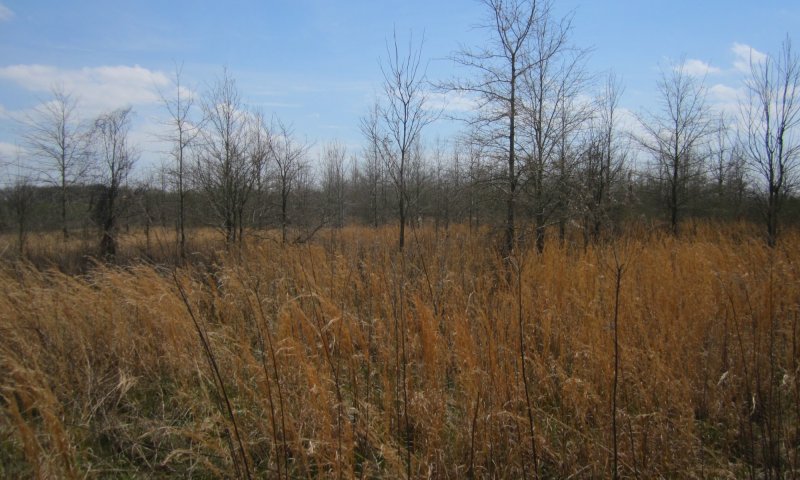
Figure 15. WRP planting on ridge and swale Dundee sil, 0-3% slopes, Bolivar Co., MS.
This community phase is representative of areas planted in tree species that are suited for and favored in management on this ecological site. Preparation of this phase may be initiated immediately following a former land use activity (e.g., State 3) or it may be started following a fallow period (Community Phase 6.1). If afforestation is initiated immediately following intensive land use without “site preparation,” potential productivity of the targeted area could be less than optimal if soil compaction, plow pan occurrence, degraded fertility, and depleted organic matter content have occurred.
The following are projected site index ranges of select tree species (tree height in feet with base age 30 years for cottonwood and 50 years for all others) whereby the soils of a given location had been under prolonged cultivation. Ranges of individual values are based on the presence of a plow pan (low value) to one where only prolonged cultivation is considered with no change in bulk density and organic matter content (high value): sweetgum – 74 to 86 feet; eastern cottonwood – 72 to 92 feet; cherrybark oak – 73 to 84 feet; water oak – 70 to 80 feet; green ash – 59 to 70 feet; Nuttall oak – 70 to 81 feet. (Site indices were derived via the models of Baker and Broadfoot, 1979, by Steve Meadows, USFS Principal Silviculturist, and shared with Rachel Stout Evans, contributing author.)
The tree species listed in the Dominant Plant Species table includes those listed above in addition to trees identified as suitable for planting on Dundee soils in Broadfoot (1976).
Pathway 6.1A
Community 6.1 to 6.2
Remove undesirable competitors; final soil preparation; establish site-appropriate species (favored in management).
State 7
Conservation (Herbaceous)
This state is representative of the range of conservation actions that may be implemented and established on this ecological site. Apart from planting trees and managing for forest, one may elect to establish native herbaceous species and manage for predominantly a native grassland; a complex mixture of native grasses and forbs; or a pollinator planting whereby native forbs dominate the mix. In each of these options, it is strongly advised (and possibly a programmatic requirement) that the species comprising the planting or seed mix consist of spring, summer, and fall flowering species. Depending on goals and objectives, various conservation programs and practices may be available. For additional information and assistance, please contact or visit the local NRCS Field Office.
Community 7.1
Pollinator Planting/Native Grasses
This community phase represents the establishment of native forbs or wildflowers for pollinator habitat and/or native grasses. The seed mix for planting may be quite varied depending on objectives and goals. Ideally, the mix includes a wide range of species that flower at various times of the growing season (spring, summer, and fall). Plant species in some pollinator mixes may include but are not limited to beebalm (Monarda spp.), milkweeds (Asclepias spp.), beardtongue (Penstemon spp.), cardinalflower (Lobelia cardinalis), vervain (Verbena spp.), various legumes such as native lespedeza (Lespedeza spp.), Illinois bundleflower (Desmanthus illinoensis), partridge pea (Chamaecrista fasciculata), and a broad assortment of composites such as asters (Symphyotrichum spp.), tickseed (Coreopsis spp.), blazing star (Liatris spp.), coneflower (Rudbeckia spp.), sunflower (Helianthus spp.) among many others. If goals and objectives are to establish native grasses within a forb mix or in a grass-dominant stand, species suitable for planting may include switchgrass (Panicum virgatum), big bluestem (Andropogon gerardii), little bluestem (Schizachyrium scoparium) Indiangrass (Sorghastrum nutans), and eastern gamagrass (Tripsacum dactyloides).
Key to the establishment of this phase is initial preparation, seeding rate, planting period, follow-up treatment, and maintenance of the planting. The selection of species to establish on any given area may ultimately depend on size and conditions of the location where the planting will occur, landowner/manager goals and objectives, and the advice and knowledge of the conservation practitioner.
Transition T1A
State 1 to 2
Stand composition is heavily altered and managed to favor select species for production (Community 2.1). This transitional pathway also includes heavy timber cutting and/or high-grading leading to Community 2.2.
Transition T1B
State 1 to 3
Actions include mechanical removal of vegetation and stumps; herbicide treatment of residual plants; and preparation for cultivation.
Transition T1C
State 1 to 5
Actions include mechanical removal of vegetation and stumps; herbicide treatment of residual plants; seedbed preparation; and establishment of desired forage.
Transition T2A
State 2 to 1
This transition represents a return to perceived reference conditions and involves the re-establishment of missing species; the control/removal of exotic species (herbicide and mechanical); stand improvement practices that favors a return of more shade intolerant components.
Transition T2B
State 2 to 3
Actions include mechanical removal of vegetation and stumps; herbicide treatment of residual plants; and preparation for cultivation.
Transition T2C
State 2 to 5
Mechanical removal of vegetation and stumps; herbicide treatment of residual plants; seedbed preparation; and establishment of desired forage.
Transition T3A
State 3 to 4
Precision land leveling
Transition T3B
State 3 to 5
Establish desired forage species and manage for grazing.
Transition T3C
State 3 to 6
Natural succession (Community 6.1) or site prep (plow pan breakup, fertilizing, etc.); planting species appropriate for site (Community 6.2)
Transition T3D
State 3 to 7
Establish select native species suitable for site; prepare site for planting (herbicide and/or mechanical)
Transition T5A
State 5 to 3
Cropland establishment: vegetation removal (mechanical/chemical) and preparation for cultivation
Transition T5B
State 5 to 6
Natural succession (Community 6.1) or site prep (plow pan breakup, fertilizing, etc.); planting species appropriate for site (Community 6.2)
Transition T5C
State 5 to 7
Establish select native species suitable for site; prepare for planting (herbicide and/or mechanical)
Transition T6A
State 6 to 3
Cropland establishment: vegetation removal (mechanical/chemical) and preparation for cultivation
Transition T6B
State 6 to 5
Actions include mechanical removal of vegetation and stumps; herbicide treatment of residual plants; establish desired forage species and manage for grazing.
Transition T7A
State 7 to 3
Cropland establishment: vegetation removal (mechanical/chemical) and preparation for cultivation
Transition T7B
State 7 to 5
Removal of vegetation; herbicide treatment of residual plants; establish desired forage species and manage for grazing
Transition T7C
State 7 to 6
Natural succession (Community 6.1) or site prep; planting species appropriate for site (Afforestation – Community 6.2).


